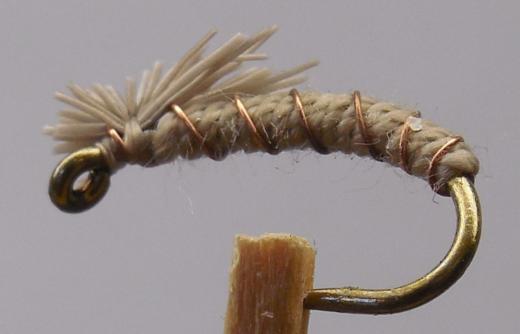Fly of the Month - Serendipity
Materials:
Hook: Tiemco 2457, sizes 14-18
Thread: 8/0 color to match body
Ribbing: Small copper wire
Body: Sewing thread (larger diameter than tying thread)
Head/wing: Deer hair
This pattern is a simple chironomid pupa, which fishes well in both lakes and rivers. It is not unusual to see midge hatches on winter days on the
Deschutes and other rivers in our area, and as spring arrives in the lakes, the fish will be eager to bulk up by gobbling these morsels which make up a huge
percentage of their available food. You’ll want to be ready for both opportunities.
These pupae are found in a variety of colors, most commonly tan, olive, brown, black and red.
1. Tie in a piece of copper wire about halfway back on the curve of the hook, with the wire sticking off the back of the hook.
2. Tie in a 4” or so piece of thread at the same point, with the thread sticking out toward the back.
3. With your fingers on the end of the thread, twist the thread “tight” so that the thread has a nice round “rope” shape, and then wind the thread forward in
tight loops to about 1/8 inch behind the eye, tie off and clip. The idea is to create a segmented (not a smooth) body.
4. Counterwrap the wire to the same point, tie off and clip.
5. Clip a small clump of deer hair, and hold it by the tips and blow into the butt ends to fluff out the fine underhair so that by lightly stroking the clump
with the other hand from the tips you are holding to the butt ends, you can remove as much of the underhair as possible.
6. Position the deer hair clump on top of the hook at the tie-in point, and holding the back (i.e., non-eye) portion of the clump tightly with your fingers,
wrap the clump onto the top of the hook with three or four tight turns. Care must be taken to keep the clump on top of the hook, not spinning around it
as you tighten the thread wraps. Then gently lift the front end of the clump up and away from the eye, and put two or three thread wraps around the hook
right behind the eye and under the clump, adding several half-hitches, and clip the thread.
7. Carefully trim the front portion of the clump at the eye to create a small head, then clip the back portion of the clump in an angle to form a small wing.
8. I finish the fly with a very small dot of head cement on the thread wraps on the bottom of the fly at the head.


